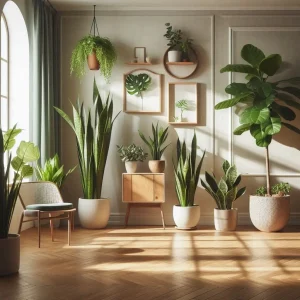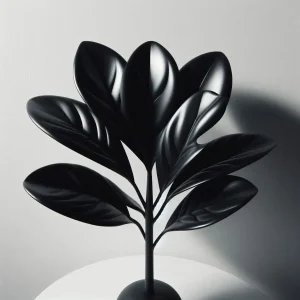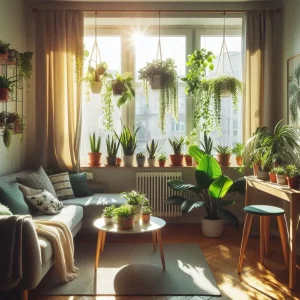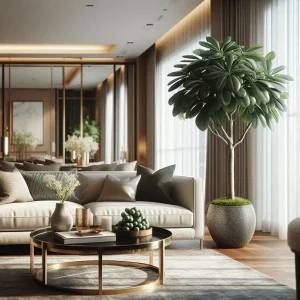Vacations, great time for family, couples and kids or even some pets like dogs, but during this event you have responsibility about the plants which are in your house. Here is thing if you know there is a vacation front of you, you should keep your plants thriving, then you have to make a plan for that. The right strategies that you planning, results proper situation for your plants. By considering the things that a plant needs to thrive such as watering, lighting and etc. You can see thriving and not just survive. A couple of this things are most important like water and light.
You have to provide sufficient moisture and watering when you are in vacation, and it depends on how much you have decided to spent your time in vacation. There are a bunch of self system watering that you could use it while you are on vacation such as wick-based setups or self-watering planters, it can provide the proper amount of water that you plants need. If you planned for shorter trip, you should water your plants and then leave for your trip, and find a place to retain enough humidity and sunlight.
| Aspect | Tips |
|---|---|
| Watering | Water plants thoroughly before leaving. Use self-watering systems (stakes, globes, wicking devices) based on plant needs and pot size. Group plants with similar watering needs together. Apply mulch (straw, wood chips, bark, compost) around the base of plants to retain moisture (2-3 inch layer). |
| Light | Adjust light exposure based on plant needs (low, moderate, or high light).Reduce overall light exposure using sheer curtains or strategically placing plants. Use timers to mimic natural light cycles if using grow lights. |
| Plants | Choose resilient plants that tolerate neglect (cacti, succulents, snake plants). Group plants with similar light and watering needs to create a microclimate. Avoid overcrowding plants to ensure proper air circulation. |
| Alternative Solutions | Ask a friend or neighbor to check on your plants and water them if needed. Utilize self-watering devices. Consider placing plants in a greenhouse or with a gardening service while you’re away. |
| Additional Tips | Test any self-watering systems or DIY setups beforehand. Adjust watering frequency based on vacation length and plant needs. Use humidity trays or misting devices for plants that require higher humidity. |
Exposure to light care is equally essential. If your greenery have become utilized to getting subjected to warm weather, consider placing them near windows which get light through filters or think about applying curtains with sheers to scatter sunlight. To prevent burning, remove houseplants which would rather dark conditions out of direct sunshine. Decrease the likelihood of infestations of insects by thoroughly inspecting your plants before leaving. As a means of security, trim any fallen foliage or blooms and think about applying soap that kills insects. If that you have a neighbor or friend who is able to assist, provide them with information about taking care of plants like watering and controlling insects. Think about combining plants that need similar attention together. You can create a small scale environment that suits all of their requirements and makes it simpler to handle their well-being when your’re absent.
Ultimately, technologies will help you. The timers can be helpful for controlling lights for growing and drip irrigation equipment. To keep up an appropriate setting, you may use humidity boxes or spraying devices. With the right mindset and some preparation, you can depart for a holiday that your plants have been properly cared for. You can make sure your plants continues developing in absence through the use of self-watering structures, periodic lighting changes, pest prevention, or requesting for the help of another person. We are going to discuss how to maintain your plants watered while on vacation as well as how to keep your plants alive while on vacation.
Watering
Page Contents
ToggleWatering is important for keeping your plants alive when you are on a vacation. We are going to tell you about and guide you how to make sure your plant receive amount of water properly when you are absence. When you decided to leave you should water your plants. This makes you sure that plants have adequate moisture levels. Using self watering will help you. Providing the system of self watering is a crucial thing that you should setup before your vacation trip. This system provides the amount of water that the plants require.
Creating your own watering system would be a great idea for you and that is simple to create additionally in this way you can save more money cause you do not need to spend a lot of money for that. You can use plastic or containers, you need to fill it up and put them upside down in the soil. Releasing water from container happens when the plants dry out. You need to place underneath of your pots a capillary mat. Underneath the reservoir is the place that the mat sits. It contacts with the soil’s pot. Water is the thing that soil needs then mat wicks water up. Using a big container for watering cotton or nylon ropes should be established. The rope have to place in water and in the end of the soil. It is acting like a channel, contribute to water to the soil. You can water the plants which are the same together. Maintaining proper moisture with create that. Wet your plants before leaving thorough the sink or shower if you have a tiny plants. Roots and foliage both can observe water. For the better process you can use mulch, it will be like wood chips or sphagnum moss, on the surface of the soil. Contributing maintain moisture that mulch does. Remember that the method you choose should be based on the specific needs of your plants and the duration of your vacation. It’s a good idea to test any self-watering systems or DIY setups before you leave to ensure they’re functioning properly. By addressing the watering needs of your plants, you’ll significantly increase their chances of surviving and thriving while you’re away.
Before we reveal another key tip for keeping your plants alive while you’re on vacation, we invite you to check out our guide to the best low-maintenance indoor plants.
Grouping Plants
Bunches plants with same take care need is efficient plan for retaining their healthy during you’re on vacation. We are going to give you some guides about how many types of the plants that you have be well-being: You need to know about humidity, watering and lighting of plants before grouping. Think about elements such as their environment’s native and patterns development. Classifying the plants based on kind of care they are need. Divide that excellent sun’s bright light from the plants which are thrive better in low light. Likewise , types of plants with the same watering repeatedly together. For some plants create microclimates with shared situations. Placing plants together raise humidity around them, the plants that are high humidity loving will appreciate for that. You can make it so much easier to manage and supply persistent levels of moisture. Making sure that grouped of plants obtain fair light. Place them close to the windows or under stimulated light resources based on their light preferences. When grouping, avoid plants overcrowded. Every last one of the plants better have satisfactory space for growth and air circulation. Wrapping revealed soil with fancy mulch or the other thing is moss, moss could helps decrease evaporation and retains moisture for soil. Create humidity-loving is gathering plants and place them in tray, fill it up with water, use humidity in the vicinity. Test your plants before your vocational trip, how much water they need over a few days. This helps you refine the arrangement and make any necessary adjustments. By grouping your plants according to their care needs, you create a more manageable and cohesive care routine. This technique increases the chances of all your plants thriving while you’re away, as they share conditions that promote their well-being.

Choose Resilient Plants
Choosing resilient plants could be a wise decision that you can make, to ensure you , when you are on the vacation your indoor garden will be survive. Here some guide on how to pick up and take care for tough plants when you are not present. Look for plants known for their capability to hanging on disregard. Cacti, juicy, plants of snake, spider plants, ZZ plants and pothos they are the plants which could be examples of Indoor resilient plants. Adapting is what the resilient plants do, they can survive on a tough situation. Looking for or search the web to find out what sort of plants are growing to be resilient. Opt for dryness tolerant plants that could resist when it’s drought without pain. Their capability to save water contributes them stay alive longer without ordinary watering. The plants which are need minimal pruning, deadheading, or ordinary fertilization should be great to be Choose. This decrease the care responsibility while you are absence. Make sure that plants you buy are pest free and healthy. The plants which are healthy can resist against all kind of temperature. Choose proper size of pots that adapting the plant’s root system. Maintaining moisture long is what plants need, pick up larger pots to holds more soil. Opt for containers made from materials that contribute ordinary levels of moisture, such as pots of clay which allows air and moisture exchange. Choosing resilient plants ensures that even if you can’t provide constant care, your indoor garden will continue to thrive. Their adaptability and tolerance to various conditions increase their chances of remaining healthy and vibrant during your vacation.
Reduce Light Exposure
Managing light exposure efficiently is crucial to ensures your plants healthy and survive during you are on vacation. Here some details to guide you about on how to decrease light exposure for indoor plants while you are on vacation: Read about the lighting requirements for every plant in the collection you have. Put them into the following three categories according to their brightness choices: low, moderate, and strong. Lighting-sensitive flowers ought to be planted in places having low light strength. Put high-light plants out of bright sunlight, for instance, and low-light plants toward windows. Build an interim shade using lightweight cloth or wire. It reduces the amount of light while not completely hiding it, maintaining plants against burning. Move the vegetation if there are openings that have different light exposures. It ensures that every plant get a comparable quantity of sunlight. Setup schedules to imitate your usual lighting cycle when you want lights for growing. This allows the plants maintain an even a pattern. Decrease your daily light hours somewhat if you’ve got the time. Decrease the time your grow lights stay on slowly in order to duplicate the natural day-night process. Test using the setup a few days beforehand your vacation to ensure that it’s successful for maintaining adequate illumination situations. Flowers put uncomfortably near openings without direct sunlight might need further protection. To prevent blisters, move them out of their window. Limit the quantity of natural daylight which reaches the space by changing your window wraps and slats. You can guarantee that the plants get enough sunlight regardless of whether you aren’t around by carefully regulating the exposure to light. This approach lowers light-related strain and enables your plants to adjust to the slightly changing conditions, promoting their health and growth when that you’re gone.
Before we reveal another key tip for keeping your houseplants alive while you’re on vacation, we invite you to also check out our article on caring for houseplants during the summer.
Self-Watering Devices
Self-watering systems could represent an effective means for keeping the plants healthy while that you’re absent. This is how to go accomplish it: Stakes, globes, and wicking devices represent a few of the different self-watering methods offered. Pick another that’s appropriate to your the plant’s demands and pot height. Before departing, fill the reservoir at the bottom of the self-watering system with water. As the holding tank dries down, it’ll slowly discharge liquid into the the plant’s soil. Just prior to you depart, give ample water to your plants. This guarantees that the ground is suitably moist whenever the self-watering system is installed. Put its self-watering mechanism into the soil as directed by the company that makes it. Ensure that it reaches the root zone. Check that the item does not obstruct drainage holes, as excess water may gather in the saucepan. To prevent water loss due to evaporated water, place the plants in an area with indirect light. If you’re utilizing self-watering devices for the first time, do a test run before going on vacation to confirm they work properly. Bear in that these self-watering equipment can’t be perfect, so having an alternate plan or a person who is able to step in if required is still a smart idea.
Mulching
Mulch is an excellent technique to keep your plants alive while you’re away. Here’s how to utilize mulch properly: Choose an appropriate mulch material, such as straw, wood chips, bark, or compost. The mulch should be organic and appropriate for the demands of your plants. Water your plants well before applying mulch to ensure the soil is adequately hydrated. Apply a layer of mulch to the base of your plants. Aim for a thickness of approximately 2-3 inches. Avoid piling mulch tightly over plant stems, because it might cause decay. Ensure that the mulch fills every inch of surface of the soil inside the drip line of the plant. This aids in the retention of moisture and the prevention of dehydration. Mulch not just keeps moisture in the soil as well, but it additionally regulates the temperature of the soil, inhibits weeds, and adds nutrients to the soil as it decomposes. Mulch slows water evaporation from the soil. Before you go, water the plants slowly and deeply to enable moisture to infiltrate the soil. various vegetation have diverse tastes. Acid-loving plants, such as roses, may benefit from pine bark mulch, whilst veggies can gain from sand mulch. Note that, although mulch assists in maintaining moisture, it’s still a good idea to have a backup plan or someone to check on your plants on a regular basis, especially if you’re gone for an extended amount of time.
Plastic Bags
For establishing use plastic bags, a fake greenhouse atmosphere is able to contribute to keep the plants of yours stay alive during you are on vacation. Here are some guides for making good use of plastic bags: To make sure that the plants are well thirsty, completely water them before putting them in plastic bags. This method works particularly well with smaller plants in containers or saplings that may be rapidly covered in a plastic bag. Choose plastic bags that are large enough to cover every plant and pot without harming the plant. If necessary, use stakes or sticks to create a tent-like structure to protect the plastic container from coming into contact with the leaves. Seal the bag loosely at the bottom to create a mini the greenhouse effect. This traps moisture, leading in a humid environment. To prevent overheating, arrange the covered plants in an area with light that is indirect. Before leaving, inspect the plants under the plastic bags to ensure that they are properly put and that all of the closures on the containers are not overly tightly closed. While bags made of plastic can help keep humidity in place, it’s still a good idea to have a backup plan somewhere to go or an individual who can check on the plants if needed. Remember that this is only a temporary solution, especially for plants that are sensitive to humidity changes. It is vital to maintain appropriate ventilation and avoid very humid conditions in order to minimize mold or sickness hazards.
In short, proper watering practices, self-watering structures, retaining suitable lighting situations, and soliciting the assistance of neighbors or close friends can all help to reduce water consumption. Contribute to the health and vitality of your plants while you’re away. You can travel with peace thinking that your favorite plants will thrive in your absence if you take these steps.
FAQs
1.How can automated watering systems aid in keeping plants alive during vacations, and why are they a convenient solution?
Automated systems provide consistent watering, preventing drought. Timed release ensures plants receive the right amount of moisture in your absence.
2.How can using plastic bags help maintain plant moisture during vacations, and what steps should be followed for effective usage?
Plastic bags create a mini greenhouse. Water plants thoroughly, cover with a bag, secure around the pot to maintain humidity while away.
3.How do choosing resilient plants contribute to plant survival during vacations, and what types of hardy plants are recommended for minimal care?
Resilient plants require less attention. Succulents, cacti, and snake plants tolerate drought, making them suitable choices when away.







